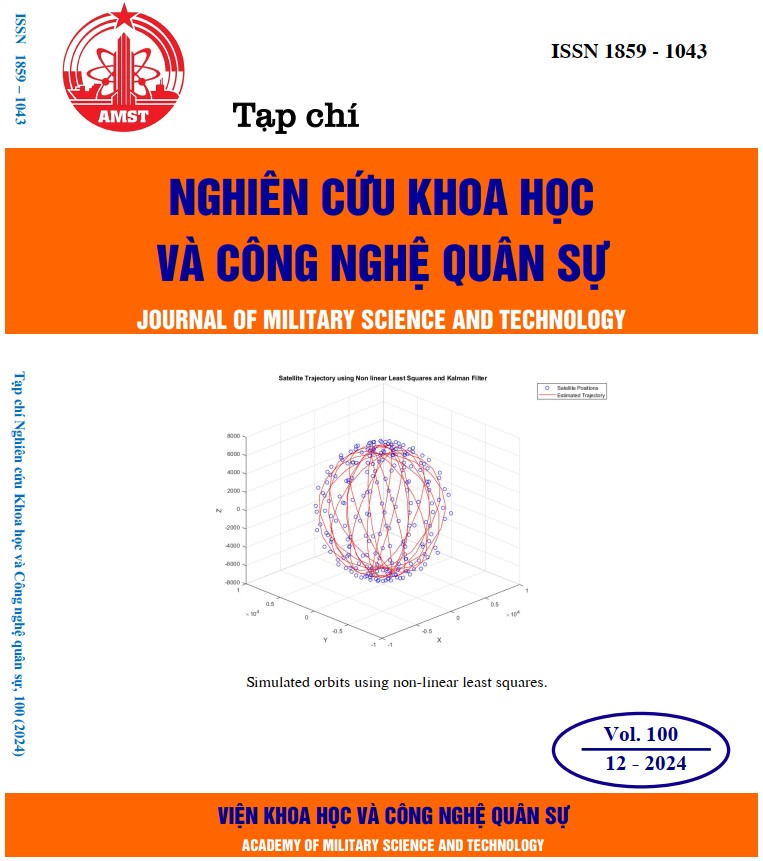Optimal slip estimator-based fixed-time control for anti-lock braking system in electric vehicles
570 viewsDOI:
https://doi.org/10.54939/1859-1043.j.mst.100.2024.22-30Keywords:
Anti-lock braking system; Fixed-time control; Global Sliding Mode Control; Optimal slip estimator.Abstract
The Anti-lock Braking System (ABS) is a safety system that prevents the wheels from locking during emergency braking, ensuring the driver can maintain control of the vehicle and optimize braking distance. Therefore, research and experimentation on a robust nonlinear controller applicable to this system are highly important and necessary. This study proposes a Fixed-Time Control (FTC) strategy, aiming to converge the slip deviation within a predetermined time interval calculated in advance. The research also suggests an optimal slip estimator combined with the controller to enhance system robustness when the vehicle operates under different road conditions. Global Sliding Mode Control (GSMC) is introduced for comparison with the proposed controller. Simulation results using CarSim software combined with MATLAB/ Simulink have demonstrated the feasibility of the system.
References
[1]. He, Lin, et al. “A combining sliding mode control approach for electric motor anti-lock braking system of battery electric vehicle.” Control Engineering Practice 102, p 104520, (2020). DOI: https://doi.org/10.1016/j.conengprac.2020.104520
[2]. Ha, Jinwoo, et al. “Extremum Seeking-based Braking Friction Force Maximization Algorithm using Fuzzy logic without Slip Ratio for ABSs,” IEEE Transactions on Intelligent Vehicles, (2024). DOI: https://doi.org/10.1109/TIV.2024.3430816
[3]. Hartikainen, L., Frank, P., and Westermann, S. “Longitudinal wheel slip during ABS brak-ing,” Vehicle System Dynamics 53.2, pp 237-255, (2015). DOI: https://doi.org/10.1080/00423114.2014.991332
[4]. Basrah, M. Sofian, et al. “Wheel slip control with torque blending using linear and nonlinear model predictive control,” Vehicle System Dynamics 55.11, pp 1665-1685, (2017).
[5]. Peng, Y., Jian, C., and Yan M. “Observer-based estimation of velocity and tire-road friction coeffi-cient for vehicle control systems” Nonlinear Dynamics 96, pp 363-387, (2019). DOI: https://doi.org/10.1007/s11071-019-04794-0
[6]. Le, D., et al. “Extended State Observer-Based Backstepping Sliding Mode Control for Wheel Slip Tracking,” The International Conference on Intelligent Systems & Networks. Singapore: Springer Nature Singapore, (2023). DOI: https://doi.org/10.1007/978-981-99-4725-6_23
[7]. Wang, H., Shaowen W., and Qianyu W. “Global sliding mode control for nonlinear vehicle antilock braking system.” IEEE Access 9, pp 40349-40359, (2021). DOI: https://doi.org/10.1109/ACCESS.2021.3064960
[8]. You, S., Jeonghwan G., and Wonhee, K. “Fixed-time slip control with extended-state observer using only wheel speed for anti-lock braking systems of electric vehicles.” IEEE Transactions on Intelli-gent Transportation Systems 23.7, pp 6368-6378, (2021). DOI: https://doi.org/10.1109/TITS.2021.3055980
[9]. Qiu, Yanan, and Zhiyong Dai. “Adaptive constrained antilock braking control under unknown time-varying slip-friction characteristics.” Nonlinear Dynamics 108.4, pp 3467-3484, (2022). DOI: https://doi.org/10.1007/s11071-022-07210-2
[10]. Fan, Yunsheng, et al. “Global fixed-time trajectory tracking control of underactuated USV based on fixed-time extended state observer.” ISA transactions 132, pp 267-277, (2023). DOI: https://doi.org/10.1016/j.isatra.2022.06.011
[11]. Yin, Dejun, et al. “A multiple data fusion approach to wheel slip control for decentralized electric vehicles.” Energies 10.4: 461, (2017). DOI: https://doi.org/10.3390/en10040461
[12]. Basrah, M. Sofian, et al. “Wheel slip control with torque blending using linear and nonlinear model predictive control.” Vehicle System Dynamics 55.11: 1665-1685, (2017). DOI: https://doi.org/10.1080/00423114.2017.1318212
[13]. Liu, Yang, et al. “An overview of finite/fixed-time control and its application in engineering systems.” IEEE/CAA Journal of Automatica Sinica 9.12: 2106-2120, (2022). DOI: https://doi.org/10.1109/JAS.2022.105413
[14]. Pretagostini, Francesco, et al. “Survey on wheel slip control design strategies, evaluation and ap-plication to antilock braking systems.” Ieee Access 8: 10951-10970, (2020). DOI: https://doi.org/10.1109/ACCESS.2020.2965644







